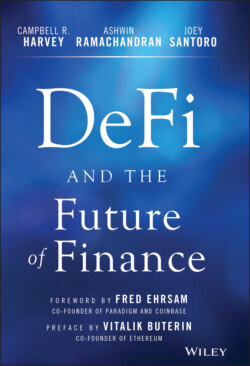Читать книгу DeFi and the Future of Finance - Campbell R. Harvey - Страница 11
ETHEREUM AND DeFi
ОглавлениеEthereum (ETH) is currently the second largest cryptocurrency by market cap ($260b). Vitalik Buterin introduced the idea in 2014, and Ethereum mined its first block in 2015. Ethereum is in some sense a logical extension of the applications of Bitcoin because it allows for smart contracts – which are code that lives on a blockchain, can control assets and data, and define interactions between the assets, data, and network participants. The capacity for smart contracts defines Ethereum as a smart contract platform.
Ethereum and other smart contract platforms specifically gave rise to the decentralized application, or dApp. The backend components of these applications are built with interoperable, transparent smart contracts that continue to exist if the chain they live on exists. dApps allow peers to interact directly and remove the need for a company to act as a central clearing house for app interactions. It quickly became apparent that the first killer dApps would be financial ones.
The drive toward financial dApps became the DeFi movement, which seeks to build and combine open-source financial building blocks into sophisticated products with minimized friction and maximized value to users. Because it costs no more at an organization level to provide services to a customer with $100 or $100 million in assets, DeFi proponents believe that all meaningful financial infrastructure will be replaced by smart contracts, which can provide more value to a larger group of users. Anyone can simply pay the flat fee to use the contract and benefit from the innovations of DeFi. We will discuss smart contract platforms and dApps in more depth in Chapter 3.
DeFi is fundamentally a competitive marketplace of financial dApps that function as various financial “primitives” such as exchange, lend, and tokenize. They benefit from the network effects of combining and recombining DeFi products and attracting increasingly more market share from the traditional financial ecosystem. Our goal in this book is to give an overview of the problems that DeFi solves, describe the current and rapidly growing DeFi landscape, and present a vision of the future opportunities that DeFi unlocks.
